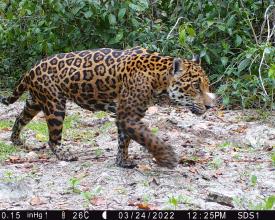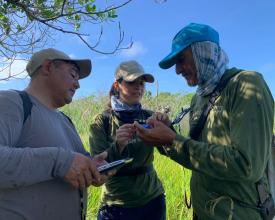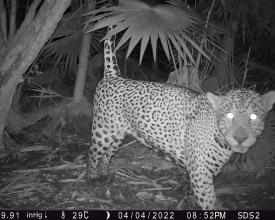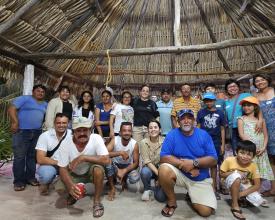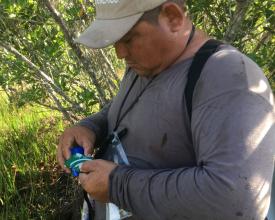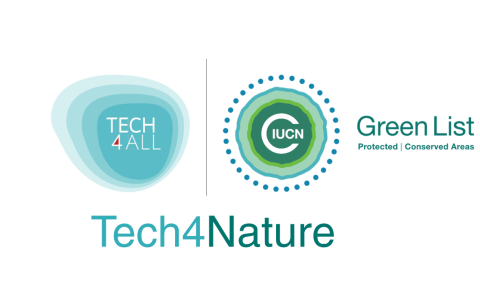
Harnessing the power of AI and community centered approaches to monitor Jaguars in the Yucatan Peninsula

Mexico is recognized as a megadiverse country, housing approximately 12% of the world's species. The country safeguards a rich natural and cultural heritage through the efforts of indigenous communities. The Yucatan Peninsula, in the southeast, is ecologically rich, featuring rainforests, coral reefs, mangroves, and more, but these ecosystems are rapidly deteriorating due to human activities and climate change. Nearly 80% of the rainforests are disturbed, with only 22% covered by mature vegetation, primarily in protected areas.
The Tech4Nature Mexico pilot project employs continuous biodiversity monitoring and artificial intelligence systems for the detection and conservation of priority species in the Dzilam State Reserve, to strengthen the understanding of the impacts of climate change on the area. This approach has been materialized through the inclusion of the community as main partners and contributors, the application of machine learning techniques and the construction of multi-sectoral alliances.
Context
Challenges addressed
Jaguar populations have lost approximately 50% of its habitat across the continent. The situation in Mexico is especially disconcerting, as the species has experienced a reduction of over 40% of its territorial range.
Meanwhile, the ecosystems of the Yucatan Peninsula (home to nearly half of the country's jaguars) are undergoing rapid degradation, with profound implications for jaguar populations, which find themselves increasingly cornered by habitat destruction, and human-jaguar conflicts. Furthermore, the Yucatan Peninsula has become a hotspot for illegal jaguar hunting and trafficking.
In the specific context of the Dzilam State Reserve, this area faces multiple threats, from land-use alterations and biodiversity loss, to heightened susceptibility to extreme weather phenomena.
Moreover, monitoring jaguars remains an resource-intensive endeavor, given the absence of surveillance mechanisms spanning vast areas, which hinders the capacity to gather crucial data for their protection.
Location
Process
Summary of the process
The Tech4Nature Mexico pilot's results exemplify holistic synergy among its building blocks, embracing a human-nature-centric approach with enduring regional impact. By uniting cutting-edge technology with a profound commitment to conservation, local perspectives, and multi-stakeholder collaborations, this pilot has not only transformed the understanding of the Reserve's extraordinary biodiversity but has also fortified local engagement to its protection.
This initiative confirmed the presence of several species at varying risk levels. This rich data underpins targeted conservation and informed decisions, empowering local communities and strengthening conservation efforts, while becoming indispensable tools for strengthening conservation efforts. Furthermore, continuous monitoring efforts and increased authorities' presence have led to a tangible reduction in human threats, underlining the impact of the community's involvement in the project.
Beyond the Reserve's boundaries, this project is catalyzing a transformative wave in regional conservation, where the fusion of advanced technology and multi-stakeholder collaboration redefines biodiversity protection.
Building Blocks
Multi-stakeholder alliance
This project, led by C Minds, the Secretariat of Sustainable Development of Yucatan (SDS), the community of the municipalities of Dzilam de Bravo and Dzilam Gonzalez in Yucatan, the International Union for Conservation of Nature (IUCN) and Huawei, in collaboration with the Polytechnic University of Yucatan (UPY) and Rainforest Connection (RFCx), and with the advice and feedback of biologists with expertise in feline conservation, combined the knowledge of different institutions and individuals to create an alliance with environmental and socioeconomic impact, both locally and regionally.
Enabling factors
The pilot carefully identified all relevant stakeholders. This includes non-profit organizations, government, academic institutions, private sector companies and local communities. Each stakeholder brought their unique expertise and perspective, contributing to the overall success of the project.
Lesson learned
Working toward shared objectives is essential to align the efforts of all stakeholders. Collaborate with stakeholders to establish clear goals and common objectives that address the needs and aspirations of each. This process should translate the goals into a "common language" that is understandable to all, promoting strong understanding and commitment.
Community co-design and engagement
The engagement of local leaders was integral from the project's inception, entrusting them with the characterization and selection of sampling and monitoring sites. Their insights and requirements were actively incorporated into the project's analysis. Timely presentation of results, widespread dissemination of their work and expertise, and inclusion in working meetings were paramount.
Enabling factors
The Ministry of Sustainable Development from Yucatan has been engaging and working with the local communities living in and around the Reserve for several years, ensuring cross-pollination of knowledge, good governance and justice.
Moreover, the C Minds' AI for Climate initiative established a robust four-year collaboration with the Yucatan government, essential local stakeholders representing academia, innovation, and civil society sectors.
Lesson learned
The comprehensive involvement of the local community across all project stages, encompassing design, deployment, data collection, and analysis, emerged as a pivotal and indispensable factor contributing to the project's successful implementation and the acquisition of valuable biodiversity information within the reserve.
Camera traps and eco-acoustic monitoring devices deployment
The local team strategically placed 15 camera traps and 30 eco-acoustic monitoring devices (audiomoths) within the mangrove and lowland rainforest habitats where jaguars have been previously sighted. This deployment effectively captured the region's biodiversity and generated valuable data for subsequent analysis.
Enabling factors
Field research, in conjunction with active participation from the local community and insights gained from co-design efforts, pinpointed the optimal locations for deploying cameras and audiomoths. These devices were strategically positioned in less disturbed areas of the mangroves, jungles, and savannahs, ensuring the success of our scientific survey.
Lesson learned
Collaborative site characterization and mapping with the local community served as a crucial foundation for the successful deployment of these devices. However, we also encountered challenges, including wildfires and extreme events, which temporarily impeded both device placement and data collection efforts.
Image recognition algorithms for jaguar detection and identification
The image recognition component, based on Convolutional Neural Networks (CNN) in the framework of the Tech4Nature Mexico pilot, plays a fundamental role by: i) Automatically detecting the presence of jaguars in camera trap captures, thus speeding up data processing; and ii) Automatically identifying individual jaguars in the region, which enhances the understanding of local populations. This approach is of vital importance in conservation by taking advantage of advanced methods that allow a faster and more detailed analysis.
Enabling factors
Data collected from the devices and strategic alliances with Huawei, UPY, and other expert conservation organizations for data sharing. During a full school year, a group of young data engineering students from UPY were dedicated to the development of the image recognition models. Given the possibility that the models could be biased in the recognition of jaguars due to the students' lack of experience in monitoring this species, the group received training and feedback from a biologist specialized in feline conservation in Yucatan.
Lesson learned
We faced a considerable challenge in developing automatic models for the detection and identification of jaguars in images. This task is complicated not only by the scarcity of available data, but also by the limited amount of images captured by camera traps containing the species of interest, due to its critical conservation status. These obstacles have been notable in the initial stages of the project, prompting us to collect animal images from a variety of sources to expand our dataset. However, complexity increases at this stage due to additional factors.
Resources
Acoustic monitoring and analyses
The acoustic component of the project holds special significance, as it played a pivotal role in the automatic detection of over 138 species, with 95 of them being integrated into our pattern matching algorithms. This forms a robust foundation for the continuous monitoring of the region over the upcoming years, allowing us to observe how various environmental factors influence species presence
Enabling factors
Our success in species detection was made possible through the data collected from the devices and the strategic partnerships we established, particularly with Rainforest Connection. Additionally, local experts played a crucial role in validating species presence.
Lesson learned
The integrated passive acoustic monitoring combined with AI techniques allowed for the identification of 95 species. There is a positive correlation between species richness and low-canopy forest cover. Furthermore, the soundscape analyses revealed variations tied to different seasons and habitat types. However, the pilot encountered the challenge of limited training data for rare species. To mitigate this, we conducted multiple rounds of sensor deployment across various seasons.
Resources
Generation of inputs for the strengthening of AI tools and resources for biodiversity protection
Among the strengths of the pilot is the ability to translate learnings into opportunities and recommendations, especially on issues of innovation, digital transformation and technological ethics for biodiversity protection. For this reason, we closely monitored the implementation of the pilot to develop a public report with a recommendations section, fed by the experiences, inputs, achievements and learnings of the implementing team.
Enabling factors
What was learned at each step and with each partner contributed to strengthening AI tools and methodologies for biodiversity protection.
Lesson learned
Beyond the boundaries of the Reserve, the Tech4Nature Mexico project has sparked a transformative wave in regional conservation efforts. The fusion of advanced technology with multi-stakeholder collaboration is redefining biodiversity protection. Innovative tracking algorithms have revealed crucial data confirming the presence of threatened species in an unprecedented way. These revelations enrich our understanding of regional ecology and empower local communities, driving lasting commitment to conservation.
Impacts
The Tech4Nature Mexico project has yielded groundbreaking results within the Dzilam State Reserve. Through advanced monitoring algorithms, the project has confirmed the presence of 146 species, including 38 at risk, reaffirming the significance of their protection. This newfound knowledge has not only enriched local communities' understanding of their environment but also empowered them to actively engage in conservation efforts. The project's automatic jaguar identification model has paved the way to enhance the protection of their habitats. Furthermore, the project's data has international implications, influencing the Reserve's inclusion in the prestigious IUCN Green List and enhancing its management program. Through continuous monitoring and community involvement, the project has reduced human threats to wildlife, ensuring a safer environment.
Some of the technical impacts of the project are:
- Over 80,000 images and videos, and over 600,000 acoustic files collected
- 4,000 hectares covered (mangroves, jungle and savannah).
- Species richness of 111 birds, 23 mammals (7 jaguars have been identified so far), 6 reptiles, 6 amphibians.
- 138 species included in the acoustic Pattern Matching models (CNN).
- 93% precision of the image algorithm capable of detecting and identifying jaguars.
Beneficiaries
- Local, regional, and national government institutions
- Indigenous Peoples and Local Communities
- AI and data practitioners and students
- Academic institutions
- Environmental organizations
- Civil society
- Private sector
Sustainable Development Goals
Story
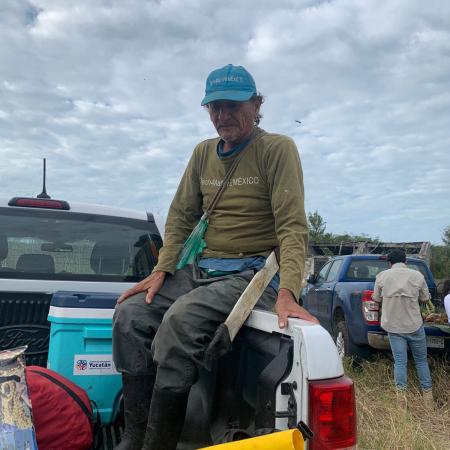
In January 1989, the Dzilam State Reserve earned its designation as a protected natural area. A groundbreaking management plan, an annual operating program, and a vigilant oversight body were established—an unprecedented leap forward in Mexican conservation history at that time. Yet, despite these strides, the management program didn't find its way into the Official Gazette of the Government of the State of Yucatan until 2005. From that point on, the reserve's approach centered on the vital notion that preserving nature must harmonize with ensuring the well-being of its inhabitants.
However, the encroachment of agriculture toward the reserve has led to the displacement of large mammal species, possibly the primary factor behind the decline in populations of magnificent big cats like the jaguar. Predators often clash with human interests as they target domestic animals, especially livestock.
Juan Castillo's upbringing was amidst a family of nomads, traversing the jungle long before it gained protected status. Settling near water sources, they thrived through hunting, farming, and cattle-raising. Juan, like his family, once believed that defending cattle against jaguars was paramount, even if it meant killing the big cats.
As years passed, he came to a profound realization—his family and he were the ones encroaching on the jaguar's habitat, consuming its resources, not the other way around. He took a bold step by removing his cattle from the reserve and relocating to the city.
Now a grandfather, Juan imparts his love for nature to his grandchildren, instilling in them the understanding that these species hold greater value alive than dead, crucial for the survival of the forest, its myriad inhabitants, and, ultimately, the people.
Today, Juan is resolute in his decision to donate his land for conservation, even though it lies within the reserve and is legally his property. Alongside his friend Benjamin, a reformed hunter, they have become eminent guides, explorers, and passionate advocates for jaguar conservation and the preservation of their prey, the rainforest, and the mangroves. They diligently tend to camera traps and acoustic monitoring devices, ensuring everyone's safety within the Teceh4Nature Mexico project. Juan Castillo has emerged as an international champion for conservation, revered for his tireless dedication to this noble cause.


